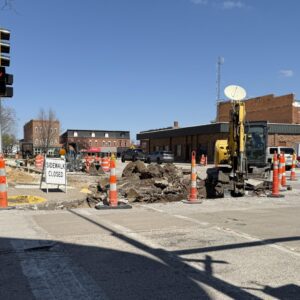Monmouth College will soon be looking back 50 years as it hosts a golden anniversary reunion of its Class of 1975. Part of the annual Golden Scots Celebration, which brings alumni back to campus from 45 years ago and beyond, the reunion will take place June 5-8.
But what about looking back 50 more years to 1925? It was a pivotal year for Monmouth College, but first let’s set the stage on the national scene. In a few ways, 1925 was an outlier.
Due to his “bellyache heard ’round the world” and a suspension for misconduct, slugger Babe Ruth belted just 25 home runs. Not coincidentally, his New York Yankees finished next-to-last in the American League. They’d rebound to win the next three AL pennants and not finish that low again until four decades later in 1966. Closer to home, Monmouth’s very own Ralph Greenleaf also had an off year. The billiards legend won World Straight Pool Championships every year from 1919-33 with three exceptions, and 1925 was one of them.
A sporting constant, however, was boxer Jack Dempsey. His reign as heavyweight champ lasted throughout the year. In addition to Ruth, Greenleaf and Dempsey, names such as Big Bill Tilden, Suzanne Lenglen and University of Illinois standout Red Grange were center stage during the midst of the Roaring ’20s.
Waid Gymnasium reaches the century mark
Why all the fuss about sports in 1925? Because that was also the year a century ago that the Monmouth College Gymnasium – also known as Waid Gymnasium – opened. The structure still stands and is an important part of the Fighting Scots athletic scene.
Waid Gym was built, in large part, because of how sports had captured the public’s attention, and certainly the attention of college students. Even as far back as three decades earlier in 1894, a Ravelings yearbook writer opined, “Monmouth College now needs a gymnasium … the students need it … the College needs it.”
The college listened, finally completing, in 1902, the structure that eventually became The Little Theater. It served as a stopgap athletic facility for several years, but it was always intended to be a temporary solution. In 1907, the fire that destroyed Old Main delayed construction of everything but its replacement, Wallace Hall, which opened in 1909. Residence halls to support a growing student population were the next priority.
Finally, in the 1920s, construction began on a permanent gymnasium for athletes. Daniel Everett Waid, an 1887 graduate of Monmouth and a New York City architect, oversaw the design of the $250,000 project. The Monmouth Review-Atlas newspaper said the facility “compares favorably with any in the state … from top to bottom.” It was named in honor of Waid, who also designed the college’s Auditorium – another building that still stands, providing further evidence of his architectural acumen.
The structure included a hardwood floor for basketball and a swimming pool – one of the finest in any of the state’s colleges, which Waid donated at a cost of $10,000 – as well as a stage, movie booth, locker rooms and a 100-yard cinder running track for training in inclement weather. The first competition in the gym was a men’s basketball game between Monmouth and Coe on Feb. 21, 1925, which the hosts won in overtime, 28-26.
“The Waid Pool was essential in getting the Navy training program during WWII,” said Monmouth emeritus history professor Bill Urban. “Without that, the loss of male students would have sunk the college. (Longtime newspaperman) Ralph Eckley told the story about his conversation with a Navy officer who had said that the college had everything the program would need, except a pool to teach flyers how to swim. Ralph said that he took him by the arm and said, ‘Let me show you something.'”
While the gym, which had balcony seating on three sides, was where much of the athletic action took place over the better part of the next 60 years, both the pool – where students were required to pass a swimming test before graduating – and the cinder running track in the “basement” still come up frequently when older alumni recall the facility. The track was phased out many years ago, but the Waid Gymnasium structure still exists as part of the Huff Athletic Center, which opened in 2003 at a cost of roughly $22 million. Waid Gym’s renovated areas house locker rooms, a training room and the Trotter Fitness Center.
The Huff Center architects delivered a masterstroke, opting to keep Waid Gym’s four iconic outer columns and brick facade – which used to face North Seventh Street – even though they were on the interior of the design.
Waid Gymnasium was formally dedicated at the alumni banquet on June 10, 1925, with legendary football coach Amos Alonzo Stagg as the principal speaker. Although Stagg made his name on the gridiron, his roots in basketball go as far back as the sport’s inventor, James Naismith, and he was instrumental to basketball’s development during its formative years.
Some memorable moments
“The first thing that comes to mind is how essential it was for athletes,” said Monmouth’s Director of Athletics Roger Haynes, a 1982 Monmouth grad, of Waid Gym. “Volleyball, basketball, baseball practice due to the weather, indoor track practice. It was also a great place to watch contests because of the balcony.”
If the indoor track was going to be used, “You had to go down and water it first,” said Haynes, “so you didn’t eat dirt the whole time you were running. We didn’t use it a ton, but we did use it.”
George Trotter ’47, who along with his wife, Maxine Murdy Trotter ’47, made the naming gift for the fitness complex, provided one of the highlights from Waid Gym’s six decades of intercollegiate competition, leading the Scots to a 70-67 upset of national power Beloit his senior year. A decade later, the 1956-57 team, led by the “Three Macs” – Jerry McBride, Bob McKee and Bob McLoskey – hosted a national tournament game in the packed gym, falling 62-52 to the University of South Dakota.
Some of the other legendary hardwood heroes from those 60 years were Bobby Woll, Donny Armstrong, Pete Kovacs, Jerry Mell, Donovan Hunter, Neil Alexander and Roger Sander. The coach of the latter trio was Terry Glasgow, who made Monmouth basketball appointment viewing over the last decade of Waid Gym’s regular use. His teams posted an overall record of 169-67 in their years with Waid as their home court, and the winning percentage in home games was much higher – over .850. They did lose the final contest in Waid, a tough 57-56 defeat in the 1982-83 Midwest Conference final. Glennie Gymnasium opened in the fall of 1983.
One of Haynes’ work-study jobs under the direction of his “Green Army” boss Don “Murph” Murphy was to mop the Waid Gym floor before Glasgow’s basketball practices.
“I’d stick around and listen him to yell at my buddies,” said Haynes, who went on to have a 38-year career in coaching, all at Monmouth. But there was more to it than that. “I learned a lot about how to run a practice.”
Other than the intercollegiate debuts of volleyball and basketball in the mid-1970s, the biggest women’s sports highlights in Waid Gymnasium came courtesy of coach Kathy Wagoner’s back-to-back conference volleyball champions in 1981 and 1982, led by such players as M Club Hall of Famers Karen Friedrich and Kim Mead.
It was before Haynes’ time, but Waid Gym also played host to a concert by a young Stevie Wonder. Concerts were a regular occasion, and Haynes recalled attending one on his first weekend as a student in 1978. Other musical legends to perform in the space were Louis Armstrong and Meredith Willson, who wrote the book, music and lyrics for The Music Man.
***Courtesy of Barry McNamara, Monmouth College***








